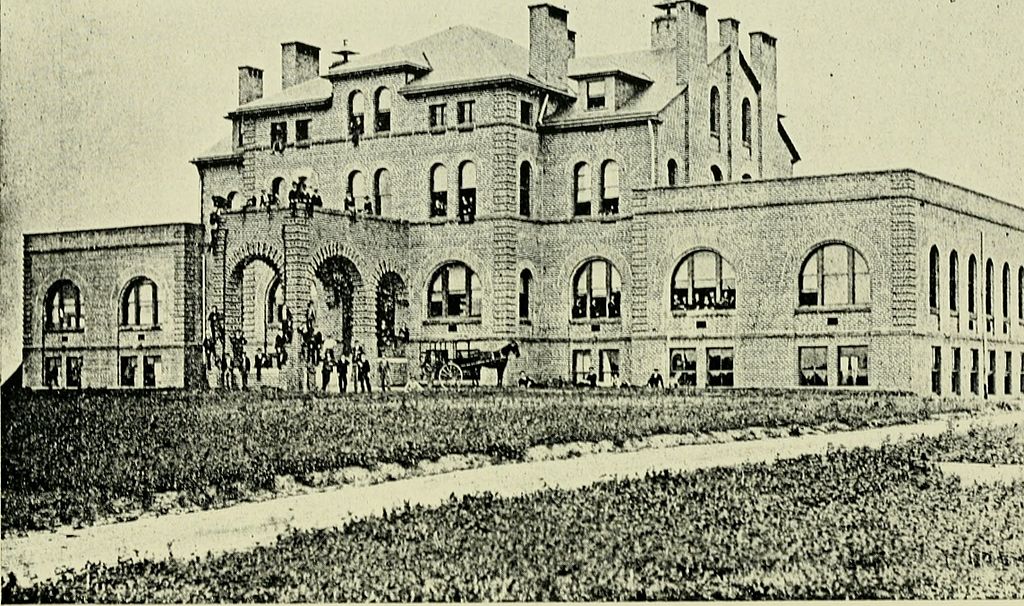![]() Introduction:
Introduction:
By 1860 there were 300 colleges in America. Nearly all of these were private colleges based upon the liberal arts tradition. In order to be admitted, one had to demonstrate proficiency in Latin and Greek. These colleges were definitely not for the “common person” but were designed for the upper classes. Less than 10% of these colleges had courses in the “Natural Philosophies” (sciences). Agriculture and Mechanical Arts were not considered to be worthy of study. Even after the passage of the Morrill Act of 1862 which established a new type of college, the land-grant college where agricultural and mechanical arts were taught, it would be many years before they overcame the stigma of being “cow colleges.” In this lesson, we will learn more about the origin and evolution of the land-grant college. The photo above is of Holladay Hall on the NCSU campus. It was the first building on campus and is now the main administrative building.
![]() Lesson Objectives:
Lesson Objectives:
At the completion of the lesson you should be able to:
- Identify the true father of the land-grant colleges.
- Describe the provisions of the Morrill Act of 1862.
- Describe the provisions of the Morrill Act of 1890.
- Discuss the 1994 land-grant colleges.
- Explain how the Morrill Act was implemented in North Carolina.
- Describe the problems encountered by the new land-grant colleges.
![]() Assignment:
Assignment:
At the first of the class, we will ask for volunteers to share an article they read from the American Farmer publication. This is a followup to the lesson from last week. Most volumes of the American Farmer have an index at the start of the publication. You can peruse the index to see if a topic grabs your interest. I recently scanned through volume II and found the following articles to be interesting:
- P. 23 – How to produce fat and white veal (I couldn’t believe the recommendation)
- p. 39 – How to eliminate bed bugs
- p. 71 – How to treat founder in horses
- p. 255 – Promotion of wooden soled shoes, especially for slaves
- p. 304 – German Farmer “Superstitions”
- p. 310 – Treating cattle for Hollow Horn disease
To provide some background for this lesson watch this video about the origins of land grant colleges (it features Iowa State University and was originally produced in 1958) https://www.youtube.com/watch?v=P0V_FZiqlbE
And they lived happily ever after. That is the way fairy tales end but the beginning of the land grant colleges was not fairy tale like. Read The Ivory Silo: Farmer-Agricultural College Tensions in the 1870s and 1880s.
![]() The PowerPoint Presentation Used with the Lesson (in PDF format):
The PowerPoint Presentation Used with the Lesson (in PDF format):
A pdf file with the PowerPoint Presentation used in this lesson can be viewed here – https://drive.google.com/file/d/13q1LEQ-_VuW-arsCBX4xky9_SrdlBnZ6/view?usp=sharing
![]() Additional Resources for Enrichment Purposes:
Additional Resources for Enrichment Purposes:
Visit the NCSU Timeline. There is also a timeline for North Carolina A&T (our 1890 land grant). There is a similar national timeline but focusing on the development of agriculture.
See the video about the People’s University – Penn State.
In 1995 the National Research Council published Colleges of Agriculture at the Land Grant Universities: A Profile. This book is on-line. Chapter 2 provides a historical overview of land grant colleges and contains some very useful information about land grant colleges.
Read the Morrill Act. If you would like to read the 2nd Morrill Act it is found on pages 311-314 of this document.
Just who was Justin Morrill (there is an error for the date of the 2nd Morrill Act – I have dropped them a note to correct it but they still haven’t)? What did he look like?
Should Jonathan Baldwin Turner be known as the Father of the Land Grant College? If you want the details about why Turner should be recognized as the Father of the Land Gant College check out this article from the Journal of the Illinois State Historical Society.
Want to know where all the land grant colleges are located? The USDA has maps showing the locations. This link allows one to search by state.
